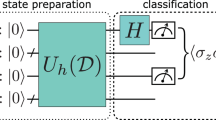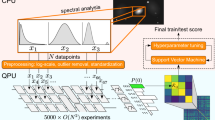Abstract
The use of kernel functions is a common technique to extract important features from datasets. A quantum computer can be used to estimate kernel entries as transition amplitudes of unitary circuits. Quantum kernels exist that, subject to computational hardness assumptions, cannot be computed classically. The learning problems for these cases are constructed artificially and it is an important challenge to find quantum kernels that have the potential to be relevant for real-world data. Here we identify a suitable class of learning problems on data that have a group structure, which are amenable to kernel methods. We introduce a family of quantum kernels that can be applied to such data, generalizing from a kernel that is known to have a quantum–classical separation when solving a particular set of problems. We use 27 qubits of a superconducting processor to demonstrate our method with a learning problem that embodies the structure of many essential learning problems on groups.
This is a preview of subscription content, access via your institution
Access options
Access Nature and 54 other Nature Portfolio journals
Get Nature+, our best-value online-access subscription
$29.99 / 30 days
cancel any time
Subscribe to this journal
Receive 12 print issues and online access
$209.00 per year
only $17.42 per issue
Buy this article
- Purchase on Springer Link
- Instant access to full article PDF
Prices may be subject to local taxes which are calculated during checkout



Similar content being viewed by others
Data availability
Experiment data are available in the Supplementary Information. Source data are provided with this paper.
Code availability
Code for training the model using kernel alignment is available through the Qiskit machine learning module: https://github.com/qiskit-community/qiskit-machine-learning.
References
Boser, B. E., Guyon, I. M. & Vapnik, V. N. A training algorithm for optimal margin classifiers. In Proceedings of the Fifth Annual Workshop on Computational Learning Theory 144–152 (Association for Computing Machinery, 1992); https://doi.org/10.1145/130385.130401
Vapnik, V., Golowich, S. E. & Smola, A., Support vector method for function approximation, regression estimation and signal processing. In Proceedings of the 9th International Conference on Neural Information Processing Systems (eds Mozer, M. et al.) 281–287 (MIT, 1996). https://doi.org/10.5555/2998981.2999021
Smola, A. J. & Schölkopf, B. A tutorial on support vector regression. Stat. Comput. 14, 199 (2004).
Ben-Hur, A., Horn, D., Siegelmann, H. T. & Vapnik, V. Support vector clustering. J. Mach. Learn. Res. 2, 125 (2002).
Girolami, M. Mercer kernel-based clustering in feature space. IEEE Trans. Neural Netw. 13, 780 (2002).
Lai, P. L. & Fyfe, C. Kernel and nonlinear canonical correlation analysis. Int. J. Neural Syst. 10, 365 (2000).
Liu, W., Principe, J. C. & Haykin, S. Kernel Adaptive Filtering: A Comprehensive Introduction, Vol. 57 (Wiley, 2011); https://doi.org/10.1002/9780470608593
Vapnik, V. The Nature of Statistical Learning Theory (Springer, 2013); https://books.google.com/books?id=EqgACAAAQBAJ
Havlíček, V. et al. Supervised learning with quantum-enhanced feature spaces. Nature 567, 209 (2019).
Schuld, M. & Killoran, N. Quantum machine learning in feature hilbert spaces. Phys. Rev. Lett. 122, 040504 (2019).
Mitarai, K., Negoro, M., Kitagawa, M. & Fujii, K. Quantum circuit learning. Phys. Rev. A 98, 032309 (2018).
Farhi, E. & Neven, H. Classification with quantum neural networks on near term processors. Preprint at https://arxiv.org/abs/1802.06002 (2018).
Grant, E. et al. Hierarchical quantum classifiers. npj Quantum Information 4, 65 (2018).
Schuld, M., Bocharov, A., Svore, K. M. & Wiebe, N. Circuit-centric quantum classifiers. Phys. Rev. A 101, 032308 (2020).
Benedetti, M., Lloyd, E., Sack, S. & Fiorentini, M. Parameterized quantum circuits as machine learning models. Quantum Sci. Technol. 4, 043001 (2019).
Liu, Y., Arunachalam, S. & Temme, K. A rigorous and robust quantum speed-up in supervised machine learning. Nat. Phys. 17, 1013 (2021).
Diaconis, P. Group Representations in Probability and Statistics, Vol. 11 (Institute of Mathematical Statistics, 1988).
Kondor, I. R. Group theoretical methods in machine learning. PhD thesis, Columbia University (2008); https://search.proquest.com/openview/d8ae7d9e47c87bb0acb05bf06ae8b6aa/1?pq-origsite=gscholar&cbl=18750&diss=y
Kondor, R. & Barbosa, M. S. Ranking with kernels in fourier space. The 23rd Conference on Learning Theory, (eds Kalaim A. & Mohrim, M.) 451–463 (COLT, 2010). http://galton.uchicago.edu/~lekheng/meetings/mathofranking/ref/kondor.pdf
Holevo, A. Covariant measurements and uncertainty relations. Rep. Math. Phys. 16, 385 (1979).
Serre, J.-P. Linear Representations of Finite Groups, Vol. 42 (Springer, 1977); https://doi.org/10.1007/978-1-4684-9458-7
Rosen, K. H. Elementary Number Theory (Pearson Education, 2011); https://books.google.com/books?id=JqycRAAACAAJ
Markov, I. L. & Saeedi, M. Constant-optimized quantum circuits for modular multiplication and exponentiation, Quantum Information and Computation 12, 361–394 (2012).
Bravyi, S. & Maslov, D. Hadamard-free circuits expose the structure of the clifford group. IEEE Trans. Infor. Theory 67, 4546 (2021).
Lloyd, S., Schuld, M., Ijaz, A., Izaac, J. & Killoran, N., Quantum embeddings for machine learning. Preprint at https://arxiv.org/abs/2001.03622 (2020).
Otten, M., Goumiri, I. R., Priest, B. W., Chapline, G. F. & Schneider, M. D. Quantum machine learning using gaussian processes with performant quantum kernels. Preprint at https://arxiv.org/abs/2004.11280 (2020).
Cristianini, N., Shawe-Taylor, J., Elisseeff, A. & Kandola, J. On kernel-target alignment. Advances in Neural Information Processing Systems 14, 367–373 (2001).
Cortes, C., Mohri, M. & Rostamizadeh, A. Algorithms for learning kernels based on centered alignment. J. Mach. Learn. Res. 13, 795 (2012).
Bullins, B., Zhang, C. & Zhang, Y. Not-so-random features. In proceedings of the 6th International Conference on Learning Representations (2017); https://openreview.net/forum?id=Hk8XMWgRb
Chamberland, C., Zhu, G., Yoder, T. J., Hertzberg, J. B. & Cross, A. W. Topological and subsystem codes on low-degree graphs with flag qubits. Phys. Rev. X 10, 011022 (2020).
Jurcevic, P. et al. Demonstration of quantum volume 64 on a superconducting quantum computing system. Quantum Sci. Technol. 6, 025020 (2021).
Gottesman, D. Stabilizer codes and quantum error correction. PhD Thesis. California Institute of Technology (1997).
Hein, M. et al. Entanglement in graph states and its applications. Preprint at https://arxiv.org/abs/quant-ph/0602096 (2006).
Temme, K., Bravyi, S. & Gambetta, J. M. Error mitigation for short-depth quantum circuits. Phys. Rev. Lett. 119, 180509 (2017).
Li, Y. & Benjamin, S. C. Efficient variational quantum simulator incorporating active error minimization. Phys. Rev. X 7, 021050 (2017).
Kandala, A. et al. Error mitigation extends the computational reach of a noisy quantum processor. Nature 567, 491 (2019).
Huang, J., Guestrin, C. & Guibas, L. Fourier theoretic probabilistic inference over permutations. J. Mach. Learn. Res. 10, 997–1070 (2009).
Bravyi, S., Gosset, D. & Movassagh, R. Classical algorithms for quantum mean values. Nat. Phys. 17, 337 (2021).
Bravyi, S., Sheldon, S., Kandala, A., Mckay, D. C. & Gambetta, J. M. Mitigating measurement errors in multiqubit experiments. Phys. Rev. A 103, 042605 (2021).
Huang, H.-Y. et al. Power of data in quantum machine learning. Nat. Commun. 12, 2631 (2021).
Acknowledgements
We thank S. Arunachalam and V. Havlicek for helpful comments and discussions and D. T. McClure and N. Sundaresan for technical assistance with the device. Funding: this work was supported by the IBM Research Frontiers Institute and K.T. acknowledges support from the ARO Grant W911NF-20-1-0014.
Author information
Authors and Affiliations
Contributions
K.T., J.M.G., J.R.G., T.P.G. and A.D.C. designed the algorithms and experiments. A.D.C., A.K. and Y.K. conducted the experiments and analysis. All authors contributed to the data analysis and writing of the manuscript.
Corresponding author
Ethics declarations
Competing interests
This work is associated with a patent application (Application No. 16/374,354).
Peer review
Peer review information
Nature Physics thanks the anonymous reviewers for their contribution to the peer review of this work.
Additional information
Publisher’s note Springer Nature remains neutral with regard to jurisdictional claims in published maps and institutional affiliations.
Supplementary information
Supplementary Information
Supplementary Text and Figs. 1–5.
Source data
Source Data Fig. 3
Experimental data in a 26-sheet Excel file displayed in the subplots of Fig. 3.
Rights and permissions
Springer Nature or its licensor (e.g. a society or other partner) holds exclusive rights to this article under a publishing agreement with the author(s) or other rightsholder(s); author self-archiving of the accepted manuscript version of this article is solely governed by the terms of such publishing agreement and applicable law.
About this article
Cite this article
Glick, J.R., Gujarati, T.P., Córcoles, A.D. et al. Covariant quantum kernels for data with group structure. Nat. Phys. 20, 479–483 (2024). https://doi.org/10.1038/s41567-023-02340-9
Received:
Accepted:
Published:
Issue Date:
DOI: https://doi.org/10.1038/s41567-023-02340-9



